ISSN ONLINE(2319-8753)PRINT(2347-6710)
ISSN ONLINE(2319-8753)PRINT(2347-6710)
M.Hari Prasad1 and P. Kowsalya2
|
| Related article at Pubmed, Scholar Google |
Visit for more related articles at International Journal of Innovative Research in Science, Engineering and Technology
Vehicular ad hoc networks (VANETs) are a promising technology to enable the communications among vehicles and between vehicles and road side units (RSU). A new algorithm to construct Stable clusters is introduced to perform cluster based routing (CBR) and to improve the performance of VANETs. The stable clustering algorithm groups the nodes based on the position and direction information to form stable clusters and elects cluster head based on a multi-metric algorithm. This method reduces the overhead of re-clustering and lead to an efficient hierarchical network topology. The proposed system is evaluated using simulation software NS2 (Network Simulator 2). The performance parameters include throughput, propagation delay and average cluster change per vehicle. Simulation results reveal that there is increase in throughput, and decrease in propagation delay and average cluster change per vehicle.
Keywords |
| CBR, cluster head, NS2, RSU, VANET, throughput, propagation delay. |
INTRODUCTION |
| Vehicular Ad-hoc Network (VANET) is a special type of mobile ad-hoc networks, which consists of a set of vehicles, equipped with a communication device called on-board unit (OBU), and a set of stationary units along the road, referred to as road side units (RSUs).Each vehicle OBU has a wireless network interface which allows the vehicle to directly connect to other vehicles and RSUs within its communication range. Some RSUs can act as a gateway for connectivity to other communication networks, such as the Internet. Based on these vehicle-to-vehicle (V2V) and vehicle-to-RSU (V2R) communications, VANETs can support a wide variety of applications in road safety, passenger infotainment, and vehicle traffic optimization. |
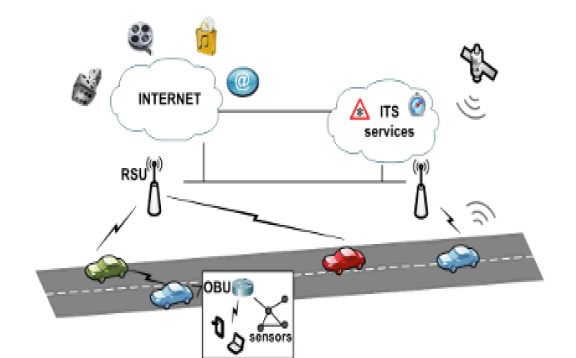 |
| Fig.1 Data Exchange in highways |
| Motivated by the importance of vehicular communications, the United States Federal Communication Commission (FCC) has allocated 75-MHz radio spectrum in the 5.9-GHz band for Dedicated Short Range Communications (DSRC) to be exclusively used by V2V and V2R communications. |
| The DSRC spectrum is divided into seven 10-MHz channels: six service channels for safety and non safety related applications, and one control channel for transmission of control information and high-priority short safety messages. Since the communication requirements of VANET safety applications are complex and demand high throughput and reliability, the design of their MAC protocol is a challenge, particularly in high-density networks. Therefore a new clustering algorithm is introduced with the aim of increasing the stability of the network topology and making it less dynamic. This algorithm groups the network nodes into clusters such that, the probability of partitioning along cluster boundaries is achieved with high probability. The main challenge in clustering is the overhead that is introduced to elect the cluster head (CH) and to maintain the membership in a highly dynamic topology. In order to reduce the overhead of re-clustering a new multi-metric election method is developed and it is used by network nodes to determine their cluster heads. |
RELATED WORKS |
| The recent years saw a research interest development on the vehicular communications technologies, focusing especially on the routing and safety issues within this environment. I present in what follows existing clustering methods and routing protocols within VANETs. Several clustering techniques for VANET have been proposed in the literature. The vehicle’s movement information is used to predict a possible link-breakage event prior to its occurrence [15]. Vehicles are grouped based on their velocity vectors. This type of grouping ensures that vehicles, belonging to the same group, are more likely to establish stable single and multihop paths as they moves together. Setting up routes that contains only vehicles from the same group ensures a high level of stable communication in VANETs. Link duration and end-to-end throughput are increased and link breakage is reduced using this stable routing method but hidden terminal problem occurs. |
| In [11], the traffic flow information is used to form clusters. cluster members selects a member that has the potential to be a cluster head longer than other cluster members and also aims to select the cluster head based on the lane where most of the traffic will flow. This method reduces the overhead of re-clustering and lead to an efficient hierarchical network topology. |
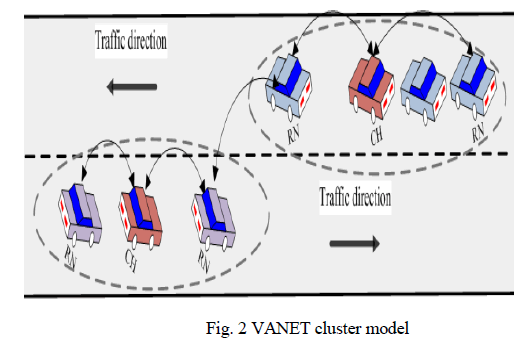 |
| In [7], a distributed multichannel and mobility-aware cluster based MAC (DMMAC) protocol is used to overcome latency and high collision rate. Through channel scheduling and an adaptive learning mechanism integrated within the fuzzy-logic inference system (FIS), vehicles organize themselves into more stable and no overlapped clusters. Each cluster will use a different subchannel from its neighbours in a distributed manner to eliminate the hidden terminal problem. The DMMAC has high stability, and its performance exceeds other protocols and can achieve a timely and reliable delivery of emergency messages to their intended recipients. |
| In [16], the cluster-based location routing (CBLR) is used in which the nodes use HELLO messages to distribute their states. When a node enters the system, it enters the undecided state and then announces itself as a CH if it does not receive a HELLO message within a period of time from other nodes; otherwise it registers at a CH as a member node. This method mainly focuses on improving routing efficiency in VANET but propagation delay occurs. In order to enhance the performance of VANETs by overcoming the drawbacks of the related works, we propose the stable clustering method. |
CLUSTERING IN VANETs |
| A cluster is a group of nodes that can communicate without disconnection and that identify themselves to be part of a cluster. These nodes select a cluster head to coordinate the communication among them. Clustering in VANETs requires selecting a cluster head that results in a stable cluster. In general, vehicles build their neighbourhood relationship using the position data embedded in the periodic messages. Usually, vehicles broadcast their current state to all other nodes within their transmission range r. Therefore, two vehicles are considered r-neighbours if the distance between them is less than r. The total number of r-neighbours of a given vehicle is called the nodal degree of the vehicle. Vehicles are assumed to utilize the control channel to exchange periodic messages and gather information about their neighbourhood, and use one service channel to define the cluster radius and perform all intra-cluster communication tasks. |
A. Neighbourhood relationship |
| The neighbourhood term is directly associated with the transmission zone of the node. To illustrate this, consider Figure 1 in which three vehicles l, m and n are located within geographical area. For node l, node n is considered a neighbour from the perspective view of the control channel, but not a neighbour from the perspective view of the service channel because the distance to l is greater than r which is the maximum range of the service channel. Node m is considered a neighbour from the perspective view of both service and control channels. |
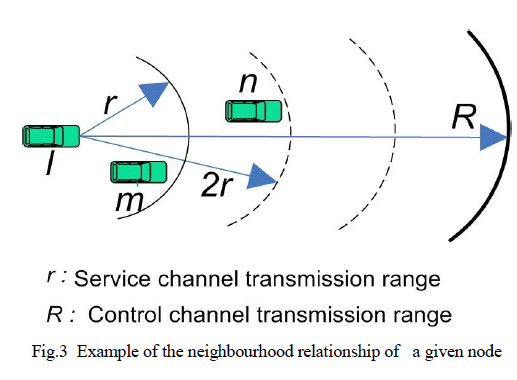 |
| Time Division Multiple Access (TDMA) scheme is adopted, in which, each vehicle reserves a TDMA channel (time slot) to broadcast its periodic beacons, which contain information to support the essential functioning of major vehicular safety applications. |
B. Cluster head selection |
| The priority of a node to become a cluster-head is determined by its suitability value, u, which is computed based on the mobility information of its neighbourhood. Nodes having higher number of stable neighbours, maintaining closer distances to their stable neighbours, and having closer speed to the average speed of their stable neighbours should have higher suitability value, thus they are more qualified to be elected as cluster-heads. |
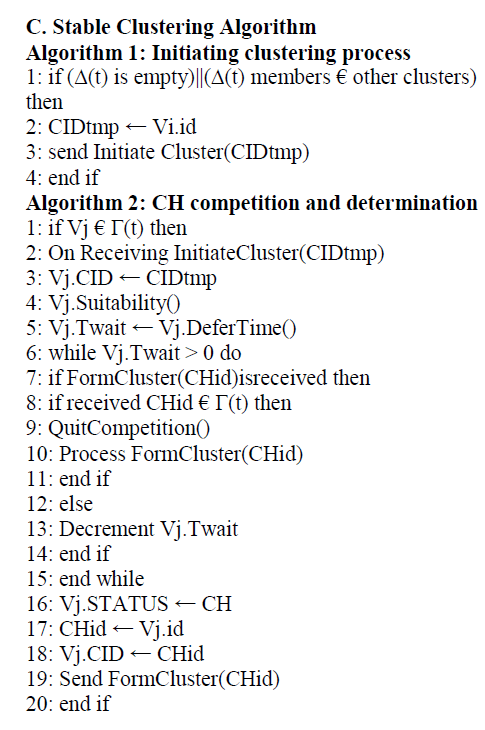 |
SIMULATION RESULTS |
| The simulation is performed using Network Simulator 2 (ns 2). Throughput, propagation delay, average cluster change per vehicle and average cluster life time are the evaluated parameters and comparison is done between Cluster Based Routing (CBR) method and Priority Based Routing (PBR) method. |
A. Throughput |
| Throughput is the average rate of successful message delivery over a communication channel. This data may be delivered over a physical or logical link, or pass through a certain network node. The throughput is usually measured in bits per second (bit/s or bps), and sometimes in data packets per second or data packets per time slot. The number of packets dropped is reduced considerably while using CBR method and it results in overall increase in throughput to 95%. |
 |
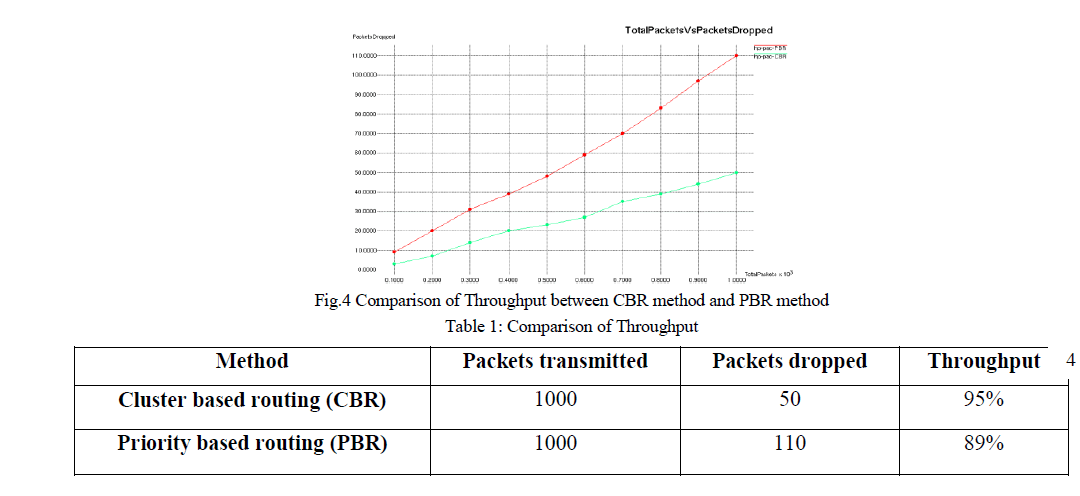 |
B. Propagation delay |
| Propagation delay is the amount of time it takes for packets to travel from the sender to the receiver. It can be computed as the ratio between the link length and the propagation speed over the specific medium. |
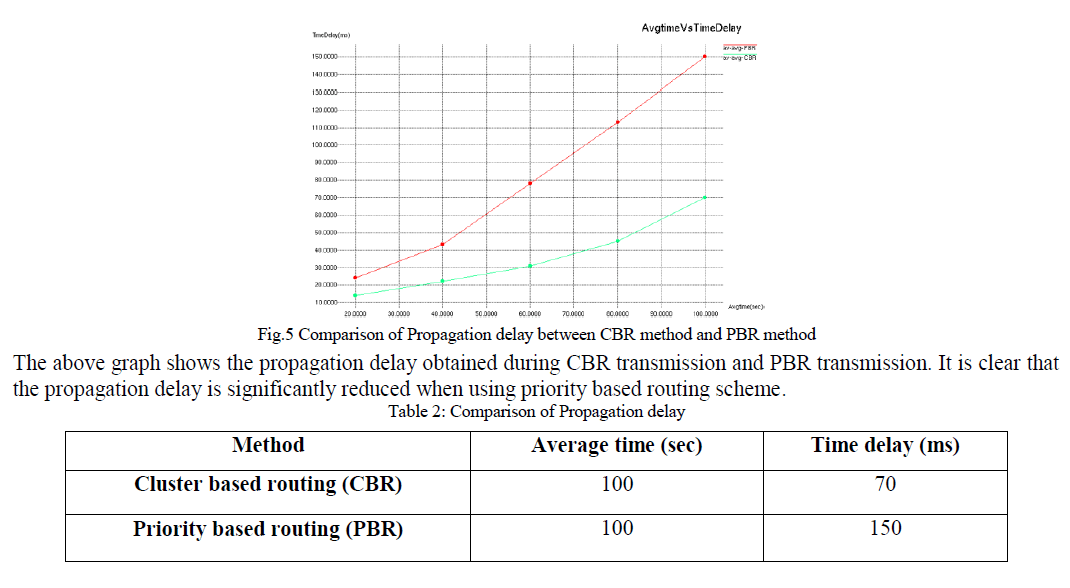 |
C. Average cluster change per vehicle |
| Good clustering algorithms should be designed to minimize the number of cluster changes of the vehicle by minimizing vehicle transitions between Clusters. The CBR method reduces average cluster change per vehicle better than Weight Based Clustering (WBC) method and helps to increase the stability of the network. |
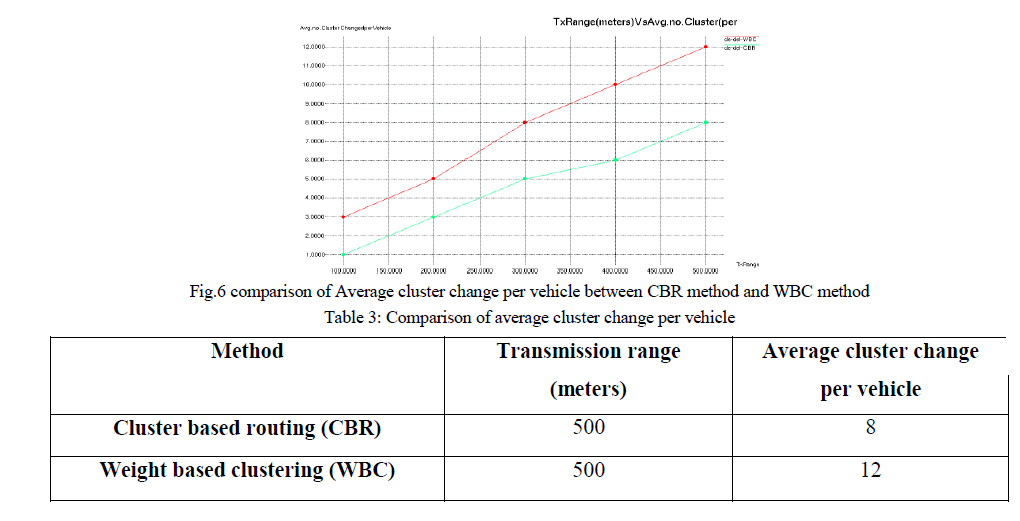 |
CONCLUSION |
| A new VANET cluster formation algorithm that groups the nodes based on the position and direction information to form stable clusters was proposed. The stable clustering algorithm elects cluster head based on a multi-metric algorithm. The proposed system is evaluated using simulation software NS2 (Network Simulator 2). Simulation results reveal that there is increase in throughput, and decrease in propagation delay and average cluster change per vehicle. Thus the performance of VANETs gets improved by providing a stable network topology. |
References |
|